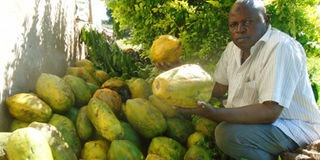Clean money from drying pawpaws

Abbas Were holds ripe pawpaws. Photo Fred Muzaale
What you need to know:
- Abbas Were has found a goldmine in adding value to pawpaws.
- He revealed to Fred Muzaale that every month he makes Shs8m.
Ten years ago, Abbas Were, a resident of Kangulumira Town in Kayunga District used to sell ripe pawpaws to middlemen.
He says the middlemen, used to pay him very little for his produce, especially during times, when there was a high supply of pawpaws on the market.
“Because of their (pawpaw) high perishability, I used to sell my produce hurriedly before they could get spoilt,” Were recounts with a smile.
Turning point
In 2007, however, Were discovered that he could dry his pawpaws and get more money than he was earning from selling fresh produce.
“The market for dry pawpaws was already there so I had no problem looking for buyers,” he says.
Investment
He began the venture by investing in buying four solar driers, each at Shs400,000. At the start, he used family labour to slice, wash and take the slices to the driers.
However, as the venture expanded, he now has 40 solar driers and employs six workers, who help him with the tedious work.
He also buys mature pawpaws from other organic farmers in the area at Shs1,000 each although during offseason, the price shoots to Shs2,000 each.
He says last October, the price for pawpaws was high because there were no pineapples on the market. Pineapples act as substitutes to pawpaws, he says.
Market
Were sells his produce to Fruits of the Nile in Jinja. Occasionally he gets cash upon delivery, although sometimes he waits for a week to pick his cheque.
Profits
Were says in a week he sells 400 kilogrammes of dry fruit at Shs8,000 per kilo. Thus, he earns about Shs3.2m and when he deducts all the costs he remains with about Shs2m a week. “In a month I get a profit of Shs8m, which is good money,” he says, although he says the price for dry pawpaws is still low compared to other dry fruits such as pineapples, jack fruit and mangoes.
Challenges
The biggest challenge he faces is that pawpaw chips spoil drying trays. This is because they stick on tray lines and in the process of removing them, the trays get spoilt. He has from time to time replaced the damaged trays.
Also, because pawpaws have a lot of water, they take long (four days) to dry compared to other fruits such as pineapples that take only two days. So he pays more to labourers.
The sap also harms his hands and he has to invest in buying protective gear to cover his body.
Future plan
He plans to buy a cutting machine so that he stops doing the work manually. This he says, takes a lot of time.
He also plans to expand on the acreage of his pawpaw plantation from one acre to two so that he does not have to buy a lot from other farmers. This would cut his production cost, he says.
Process
Harvest mature pawpaws and store them to ripen. Peel the ripe pawpaws and slice them. Place the slices on clean trays and place them in a solar drier. They will be ready after four days.
It is easy to grow the ordinary pawpaw tree from seed.
•Wash the seeds from a ripe pawpaw.
•Squeeze the seeds from the jelly bag that covers each seed. The seeds will only grow if you remove the bag.
•Dry them in a shady place.
•Store in a tightly closed container and keep them until December.
•Plant the seeds in December. Put five seeds in a hole. Do not put any compost or manure into the holes.
•Keep the small plants moist.
•You can only tell which trees are female and which are male when the trees start to flower. Therefore, you should always have more than one tree per hole, because then you can select the female trees.
Planting
•Dig a hole about twice the size of the bag in which the young tree is growing.
•Remove the soil from the hole and add some compost and manure.
•Mix this with some of the soil that has been dug out.
•Take the plant out of the container. If it is a plastic container, just cut it open at the side.
•Do not disturb the roots.
•Place the tree in the centre of the hole. When you fill up the hole hold the tree so that its base is level with the surrounding ground.
•Raise the soil around the tree to dam the water (rain or irrigation).
•Do not plant the tree deeper than it was in the container.
•Do not cover the stem with soil because it will rot.
Water
•Pawpaws need little water.
•They will, however, give more and bigger fruit if they are watered every two weeks in the dry season. The flowers will drop if they do not get enough water.
•If they are planted in clay soils, make sure that the soil does not stay too wet.
•To avoid waterlogging in clay soil, make a ridge and plant the papayas on the ridge.
.




